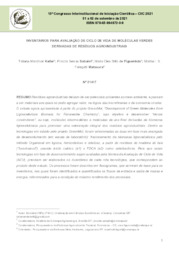Inventários para avaliação de ciclo de vida de moléculas verdes derivadas de resíduos agroindustriais.
Inventários para avaliação de ciclo de vida de moléculas verdes derivadas de resíduos agroindustriais.
Author(s): KELLER, T. M.; SABAINI, P. S.; FIGUEIREDO, M. C. B. de; MATSUURA, M. I. da S. F.
Summary: Resumo: Resíduos agroindustriais deixam de ser potenciais poluentes ao meio ambiente, e passam a ser materiais aos quais se pode agregar valor, na lógica das biorrefinarias e da economia circular. O estudo agora apresentado é parte do projeto GreenMol, "Development of Green Molecules from Lignocellulosic Biomass for Renewable Chemistry", cujo objetivo é desenvolver "blocos construtores", ou seja, moléculas intermediárias e moléculas de uso final derivadas de biomassa lignocelulósica para promover uma valorização integral dos resíduos agroindustriais. Dentre as tecnologias em estudo pelo projeto GreenMol, foram selecionadas as duas em fase mais avançada de desenvolvimento (em escala de laboratório): fracionamento da biomassa lignocelulósica pelo método Organocat em lignina, hemicelulose e celulose, a partir de resíduos de madeira de faia ("beechwood"), usando ácido oxálico (a1) e FDCA (a2) como catalisadores. Para que essas tecnologias em fase de desenvolvimento sejam avaliadas pela técnica da Avaliação de Ciclo de Vida (ACV), precisam ser elaborados os inventários de cada rota tecnológica, que correspondem ao produto deste estudo. Os processos foram descritos em fluxogramas, que serviram de base para os inventários, nos quais foram identificados e quantificados os fluxos de entrada e saída de massa e energia, referenciados para a condição de máximo rendimento dos processos. Abstract: Agro-industrial residues are no longer potential pollutants to the environment, and become materials to which value can be added, in the logic of biorefineries and the circular economy. The study now presented is part of the GreenMol project, "Development of Green Molecules from Lignocellulosic Biomass for Renewable Chemistry", whose objective is to develop "building blocks", intermediate molecules and end-use molecules derived from lignocellulosic biomass to promote a full valuation of agro-industrial residues. Among the technologies being studied by the GreenMol project, the two at the most advanced stage of development were selected (on a laboratory scale): fractionation of lignocellulosic biomass by the Organocat method into lignin, hemicellulose and cellulose, from beechwood residues, using oxalic acid (a1) and FDCA (a2) as catalysts. In order to evaluate these developing technologies using the Life Cycle Assessment (LCA) technique, inventories of each technological route, which correspond to the product of this study, need to be prepared. The processes were described in flowcharts, which served as the basis for the inventories, in which the input and output flows of mass and energy were identified and quantified, referenced to the condition of maximum performance of the processes
Publication year: 2021
Types of publication: Paper in annals and proceedings
Unit: Embrapa Agroenergy
Observation
Some of Embrapa's publications are published as ePub files. To read them, use or download one of the following free software options to your computer or mobile device. Android: Google Play Books; IOS: iBooks; Windows and Linux: Calibre.
Access other publications
Access the Agricultural Research Database (BDPA) to consult Embrapa's full library collection and records.
Visit Embrapa Bookstore to purchase books and other publications sold by Embrapa.

